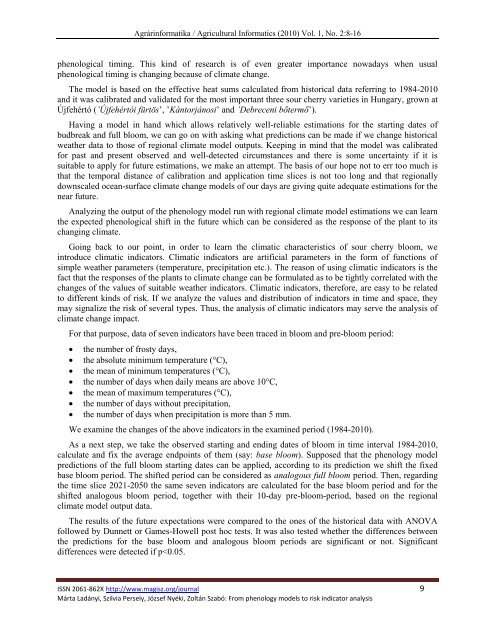The issue in pdf format, Vol 1, No 2 - Journal of Agricultural Informatics
The issue in pdf format, Vol 1, No 2 - Journal of Agricultural Informatics
The issue in pdf format, Vol 1, No 2 - Journal of Agricultural Informatics
Create successful ePaper yourself
Turn your PDF publications into a flip-book with our unique Google optimized e-Paper software.
Agrár<strong>in</strong><strong>format</strong>ika / <strong>Agricultural</strong> In<strong>format</strong>ics (2010) <strong>Vol</strong>. 1, <strong>No</strong>. 2:8-16<br />
phenological tim<strong>in</strong>g. This k<strong>in</strong>d <strong>of</strong> research is <strong>of</strong> even greater importance nowadays when usual<br />
phenological tim<strong>in</strong>g is chang<strong>in</strong>g because <strong>of</strong> climate change.<br />
<strong>The</strong> model is based on the effective heat sums calculated from historical data referr<strong>in</strong>g to 1984-2010<br />
and it was calibrated and validated for the most important three sour cherry varieties <strong>in</strong> Hungary, grown at<br />
Újfehértó (’Újfehértói fürtös’, ’Kántorjánosi’ and ’Debreceni bőtermő’).<br />
Hav<strong>in</strong>g a model <strong>in</strong> hand which allows relatively well-reliable estimations for the start<strong>in</strong>g dates <strong>of</strong><br />
budbreak and full bloom, we can go on with ask<strong>in</strong>g what predictions can be made if we change historical<br />
weather data to those <strong>of</strong> regional climate model outputs. Keep<strong>in</strong>g <strong>in</strong> m<strong>in</strong>d that the model was calibrated<br />
for past and present observed and well-detected circumstances and there is some uncerta<strong>in</strong>ty if it is<br />
suitable to apply for future estimations, we make an attempt. <strong>The</strong> basis <strong>of</strong> our hope not to err too much is<br />
that the temporal distance <strong>of</strong> calibration and application time slices is not too long and that regionally<br />
downscaled ocean-surface climate change models <strong>of</strong> our days are giv<strong>in</strong>g quite adequate estimations for the<br />
near future.<br />
Analyz<strong>in</strong>g the output <strong>of</strong> the phenology model run with regional climate model estimations we can learn<br />
the expected phenological shift <strong>in</strong> the future which can be considered as the response <strong>of</strong> the plant to its<br />
chang<strong>in</strong>g climate.<br />
Go<strong>in</strong>g back to our po<strong>in</strong>t, <strong>in</strong> order to learn the climatic characteristics <strong>of</strong> sour cherry bloom, we<br />
<strong>in</strong>troduce climatic <strong>in</strong>dicators. Climatic <strong>in</strong>dicators are artificial parameters <strong>in</strong> the form <strong>of</strong> functions <strong>of</strong><br />
simple weather parameters (temperature, precipitation etc.). <strong>The</strong> reason <strong>of</strong> us<strong>in</strong>g climatic <strong>in</strong>dicators is the<br />
fact that the responses <strong>of</strong> the plants to climate change can be formulated as to be tightly correlated with the<br />
changes <strong>of</strong> the values <strong>of</strong> suitable weather <strong>in</strong>dicators. Climatic <strong>in</strong>dicators, therefore, are easy to be related<br />
to different k<strong>in</strong>ds <strong>of</strong> risk. If we analyze the values and distribution <strong>of</strong> <strong>in</strong>dicators <strong>in</strong> time and space, they<br />
may signalize the risk <strong>of</strong> several types. Thus, the analysis <strong>of</strong> climatic <strong>in</strong>dicators may serve the analysis <strong>of</strong><br />
climate change impact.<br />
For that purpose, data <strong>of</strong> seven <strong>in</strong>dicators have been traced <strong>in</strong> bloom and pre-bloom period:<br />
<br />
<br />
<br />
<br />
<br />
<br />
<br />
the number <strong>of</strong> frosty days,<br />
the absolute m<strong>in</strong>imum temperature (°C),<br />
the mean <strong>of</strong> m<strong>in</strong>imum temperatures (°C),<br />
the number <strong>of</strong> days when daily means are above 10°C,<br />
the mean <strong>of</strong> maximum temperatures (°C),<br />
the number <strong>of</strong> days without precipitation,<br />
the number <strong>of</strong> days when precipitation is more than 5 mm.<br />
We exam<strong>in</strong>e the changes <strong>of</strong> the above <strong>in</strong>dicators <strong>in</strong> the exam<strong>in</strong>ed period (1984-2010).<br />
As a next step, we take the observed start<strong>in</strong>g and end<strong>in</strong>g dates <strong>of</strong> bloom <strong>in</strong> time <strong>in</strong>terval 1984-2010,<br />
calculate and fix the average endpo<strong>in</strong>ts <strong>of</strong> them (say: base bloom). Supposed that the phenology model<br />
predictions <strong>of</strong> the full bloom start<strong>in</strong>g dates can be applied, accord<strong>in</strong>g to its prediction we shift the fixed<br />
base bloom period. <strong>The</strong> shifted period can be considered as analogous full bloom period. <strong>The</strong>n, regard<strong>in</strong>g<br />
the time slice 2021-2050 the same seven <strong>in</strong>dicators are calculated for the base bloom period and for the<br />
shifted analogous bloom period, together with their 10-day pre-bloom-period, based on the regional<br />
climate model output data.<br />
<strong>The</strong> results <strong>of</strong> the future expectations were compared to the ones <strong>of</strong> the historical data with ANOVA<br />
followed by Dunnett or Games-Howell post hoc tests. It was also tested whether the differences between<br />
the predictions for the base bloom and analogous bloom periods are significant or not. Significant<br />
differences were detected if p



